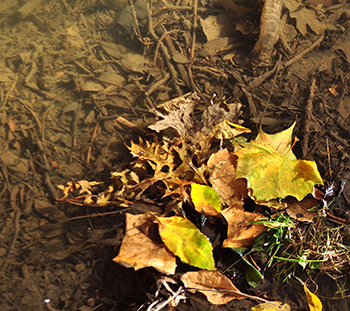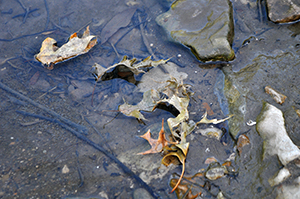Fall Leaves – Trash or Treasure?
Return to Trees and Shrubs Agent Articles
 It’s all a matter of perspective. Most people consider fall leaves as trash. I would like to challenge that thinking. Instead, view leaves as a waste that has value. The key is knowing how to properly repurpose and manage them. Let’s look at how to switch leaves into treasure.
It’s all a matter of perspective. Most people consider fall leaves as trash. I would like to challenge that thinking. Instead, view leaves as a waste that has value. The key is knowing how to properly repurpose and manage them. Let’s look at how to switch leaves into treasure.
The problem with leaves
Leaves are work. They must be removed from the lawn or they’ll suffocate the grass, killing it over the winter. But leaves create problems when not disposed of properly. Leaves from neighborhood trees that exit your yard create serious problems elsewhere.
In the woods, leaves fall naturally into streams. Streams and ponds can handle this natural loading and survive in balanced harmony with fish and wildlife. Excess leaves unbalance this natural loading. Leaves raked into or left in the streets pile up and move downhill when it rains, flowing into storm drains. This is where the problems start. Large masses can plug the storm drain causing water to backup. This backup can flood streets leading to accidents. Leaves entering storm drains wash directly into county streams, overloading the water with organic matter. Leaves are full of nutrients, phosphates and nitrogen. Leaves that naturally fall into streams contribute to this issue, but the waterway can handle this breakdown for a healthy ecosystem.
Leaves entering storm drains wash directly into county streams, overloading the water with organic matter. Leaves are full of nutrients, phosphates and nitrogen. Leaves that naturally fall into streams contribute to this issue, but the waterway can handle this breakdown for a healthy ecosystem.
Streams overloaded with leaves quickly get out of balance. This imbalance results in fish and aquatic life kills. Imbalances also result in excessive spring algae growth in neighborhood ponds. Homes associations spend thousands of dollars to treat their ponds. No one wants to look at pond scum.
Avoid the quickest way to get rid of leaves
When leaves are viewed as trash it is easy to think, “What is the quickest way to get rid of them?” As a result many people sweep or blow them into the street. While it’s an easy solution it creates problems downstream for all. Please do not rake leaves off the lawn into the streets. Better yet, when raking your lawn remove the leaves from the street gutter to reduce their impact on our water quality.
Eco-friendly disposal options for leaves
There are several ways to properly handle leaves.
1. Bagging and curbside pick-up
County residents have the option of raking up the leaves and placing them in paper lawn bags, sending them off to a municipal or commercial composting facility. Although this option may be best for many, it is work and the expense of bags adds up. It keeps our water clean but also adds to our carbon footprint.
2. Mulch Mowing
The best option is to turn trash into valued treasure and recycle the leaves at home. The easiest option is mulch mowing. Your lawn mower does the work for you.
Mulch mowing requires mowing frequently so that the blades finely chop the leaves, allowing them to naturally break down and return nutrients to the soil. Leaves can be safely returned into the grass as long as they do not pile up on the turf. How to mulch mow fall leaves.
3) Free mulch
Leaves also can be bagged by the mower and used as mulch. Leaves are the mulch of the forest floor so why not use it in your own landscape instead of buying mulch each spring? You cannot get more local than that, and it’s free. Simply empty the mower bag around your trees and shrubs.
4) Compost — Black gold
Composting is another option for many. Composting takes effort. But the return of rich organic matter is wonderful for our clay soils. How to compost
It all boils down to your perspective. If viewed as trash fall leaf removal becomes a chore. They become a treasure when you see their value and use them to improve your landscape.
No matter your mindset, avoid the temptation to rake leaves into the street. They overload streams and ponds affecting the water quality. Fresh, clean water is the basis of life for all. More information about fall leaf management can be found at johnson.k-state.edu.
Have questions?
The Garden Hotline is staffed by trained EMG volunteers and Extension staff who will assist you with questions.
Phone: (913) 715-7050
Email: garden.help@jocogov.org